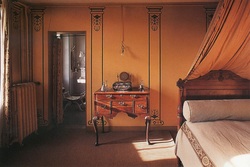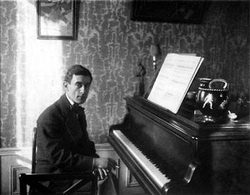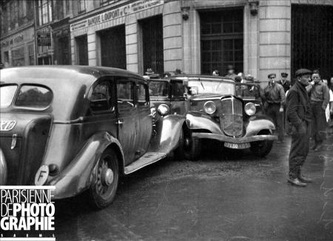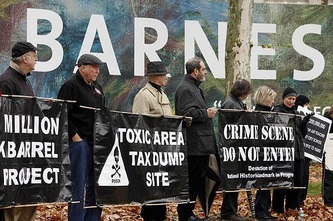
Two car accident in Paris
On September 8, 1932, a taxi crashes in the busy Parisian streets and one of its occupants violently hits his head. Apparently recovered at first, his communication and expression abilities quickly deteriorated, to the point that five years later his doctors thought he had developed a brain tumour and decided to perform brain surgery. The intervention revealed a collapsed left brain hemisphere, promptly filled up with serum. Nevertheless, entering deep coma, the patient would die nine days later, aged 62. Mankind had just lost one of its most emblematic creators: Maurice Ravel, renowned French composer, major figure of 20th century music.
On September 8, 1932, a taxi crashes in the busy Parisian streets and one of its occupants violently hits his head. Apparently recovered at first, his communication and expression abilities quickly deteriorated, to the point that five years later his doctors thought he had developed a brain tumour and decided to perform brain surgery. The intervention revealed a collapsed left brain hemisphere, promptly filled up with serum. Nevertheless, entering deep coma, the patient would die nine days later, aged 62. Mankind had just lost one of its most emblematic creators: Maurice Ravel, renowned French composer, major figure of 20th century music.
Ravel composed some of the most extensively performed musical pieces of the last hundred years: the Bolero, his piano music - including the concertos, chamber and orchestral music, are an essential part of the 20th century repertoire. Therefore, his music is worth millions in yearly authorship and edition copyrights: an estimate of €35 million over the past 25 years.
After Ravel's death, in 1937, his properties (including the intellectual) were inherited by his brother, Edouard, who managed it wisely and transformed Ravel's house into a museum. But the course of events would suffer new shift: a violent car accident left Edouard and his wife incapacitated. Needing for care, they hired Jeanette Taverne and her husband Alexander as nurse and chauffeur. After a couple of years, Edouard's wife died and the Tavernes moved into the house - and soon into Ravel's estate.
After Ravel's death, in 1937, his properties (including the intellectual) were inherited by his brother, Edouard, who managed it wisely and transformed Ravel's house into a museum. But the course of events would suffer new shift: a violent car accident left Edouard and his wife incapacitated. Needing for care, they hired Jeanette Taverne and her husband Alexander as nurse and chauffeur. After a couple of years, Edouard's wife died and the Tavernes moved into the house - and soon into Ravel's estate.

A car accident in Merion, Pennsylvania
Dr. Albert C. Barnes was a medical researcher who patented Argyrol, an anti-septic drug, making a fortune by selling his medicine and later his enterprise, in 1929. From that moment onwards he turned to art collecting and philanthropy. Together with his wife, Laura, and with the collaboration of thinkers and creators such as Bertrand Russel or Matisse, they established the Barnes foundation in 1922, dedicated to provide education and access to art.
While driving back home, July 21, 1951, he didn't stop for a stop sign he didn't agree to. His car was hit by a truck and he died immediately.
Including Van Gogh's, 9 Cézannes, 60 Matisses, 44 Picassos and around 170 Renoirs, sculptures, decorative art pieces, textiles, metal work, etc. - an overall of more than 2500 pieces from a myriad of cultures, places and times, the Barnes collection is estimated worth 30.000 Million dollars, making it probably the world's most valuable private art collection.
Dr. Albert C. Barnes was a medical researcher who patented Argyrol, an anti-septic drug, making a fortune by selling his medicine and later his enterprise, in 1929. From that moment onwards he turned to art collecting and philanthropy. Together with his wife, Laura, and with the collaboration of thinkers and creators such as Bertrand Russel or Matisse, they established the Barnes foundation in 1922, dedicated to provide education and access to art.
While driving back home, July 21, 1951, he didn't stop for a stop sign he didn't agree to. His car was hit by a truck and he died immediately.
Including Van Gogh's, 9 Cézannes, 60 Matisses, 44 Picassos and around 170 Renoirs, sculptures, decorative art pieces, textiles, metal work, etc. - an overall of more than 2500 pieces from a myriad of cultures, places and times, the Barnes collection is estimated worth 30.000 Million dollars, making it probably the world's most valuable private art collection.

For this legacy, Barnes made a few impositions - the collection could never be sold or borrowed and could never leave the Barnes' mansion, headquarters of the foundation. His main concerns were to keep the collection out of the reach of the political and social-academical circles and assure its educational relevance - basically, that it wasn't directly or indirectly monetized.
Besides the relevance of car accidents in their lives and deaths, Maurice Ravel and Albert Barnes shared other key feature: they didn't have children, their assets worth millions and their taste was unique. And, most of all, their assets were literally stolen.
Besides the relevance of car accidents in their lives and deaths, Maurice Ravel and Albert Barnes shared other key feature: they didn't have children, their assets worth millions and their taste was unique. And, most of all, their assets were literally stolen.

Stolen legacies
Pursuing his brother's ideals of valorisation of French music, Edouard Ravel's intention was to offer most of his brother's work revenues to the city of Paris and create a "Nobel Prize for music". On the other hand, Barnes desperately tried to make sure that his assets would never fall into the hands of the people and institutions he hated the most: the social and political elite of Philadelphia and the city's Museum. Unfortunately, both were deceived in their plans: Ravel's assets fell into the hand of private companies and Barnes' were taken by Philadelphia's influent people and institutions.
Being very different in their particular aspects, the overall contour of the two stories is the same: greedy people, making use of public institutions, manipulated the system to gain possession of assets, deliberately stealing and offending their original authors and owners' memories.
Pursuing his brother's ideals of valorisation of French music, Edouard Ravel's intention was to offer most of his brother's work revenues to the city of Paris and create a "Nobel Prize for music". On the other hand, Barnes desperately tried to make sure that his assets would never fall into the hands of the people and institutions he hated the most: the social and political elite of Philadelphia and the city's Museum. Unfortunately, both were deceived in their plans: Ravel's assets fell into the hand of private companies and Barnes' were taken by Philadelphia's influent people and institutions.
Being very different in their particular aspects, the overall contour of the two stories is the same: greedy people, making use of public institutions, manipulated the system to gain possession of assets, deliberately stealing and offending their original authors and owners' memories.

Valses macabres
In the case of Ravel, the story is surrounded by singular events - after announcing his supra-cited wishes of donating a substantial part of his rights to Paris, Edouard Ravel unexplainably changed his mind and left everything to his care giver and nurse, Jeanette. Then, Jean-Jacques Lemoine, legal director of SACEM (France's copyright society) understood the unique opportunity and created ARIMA, a private company settled in Gibraltar. He quits SACEM and, via several manoeuvres, managed to get Ravel's rights represented by ARIMA. At this point, Jean-Manuel de Scarano, the owner of Durand (Ravel's editor), plays a key-role. Conveniently being as well the President of the French Association of Publishers, he lobbied the French Government to extend copyright duration from 50 to 70 years. Since then the city of Paris has tried to revert this situation, without success.
(these facts were mostly taken from the full story about Ravel's assets, investigated by Jon Henley)
In the case of Ravel, the story is surrounded by singular events - after announcing his supra-cited wishes of donating a substantial part of his rights to Paris, Edouard Ravel unexplainably changed his mind and left everything to his care giver and nurse, Jeanette. Then, Jean-Jacques Lemoine, legal director of SACEM (France's copyright society) understood the unique opportunity and created ARIMA, a private company settled in Gibraltar. He quits SACEM and, via several manoeuvres, managed to get Ravel's rights represented by ARIMA. At this point, Jean-Manuel de Scarano, the owner of Durand (Ravel's editor), plays a key-role. Conveniently being as well the President of the French Association of Publishers, he lobbied the French Government to extend copyright duration from 50 to 70 years. Since then the city of Paris has tried to revert this situation, without success.
(these facts were mostly taken from the full story about Ravel's assets, investigated by Jon Henley)

The Barnes case was even more complex. After Barnes' death, his foundation was managed by a Board of Trustees. When the people that Barnes had personally named were dead, the Lincoln University remained and took over. As the Barnes collection could not be sold or taken from the Merion property, its conservation and the building's maintenance raised financial issues. These were gradually used as an excuse to a serious of infractions to Barnes' will: liberalisation of visits, a substantial world tour with many pieces and, finally, the addition of several "charity" societies in the Foundation's board, in exchange for a few million dollars to Lincoln U.
Soon these institutions lobbied politicians and manipulated the judicial system. Their intention: take over the collection and transfer it to the city centre, using it as a touristic attraction. And they succeeded.
Collaborators, former students and friend of the Barnes and many anonymous supporters joined the cause of trying to stop the process that would definitely strip the Barnes legacy from its original location and spirit. But with the full and criminous cooperation of Philadelphia's political and judicial forces, it was barely unstoppable. So, in one of the most controversial art-management processes ever, the new Barnes Foundation opened its doors in May 2012, in a brand-new building in the centre of Philadelphia.
(these facts were mostly taken from The art of the steal, 2009, a documentary by Don Argott)
Soon these institutions lobbied politicians and manipulated the judicial system. Their intention: take over the collection and transfer it to the city centre, using it as a touristic attraction. And they succeeded.
Collaborators, former students and friend of the Barnes and many anonymous supporters joined the cause of trying to stop the process that would definitely strip the Barnes legacy from its original location and spirit. But with the full and criminous cooperation of Philadelphia's political and judicial forces, it was barely unstoppable. So, in one of the most controversial art-management processes ever, the new Barnes Foundation opened its doors in May 2012, in a brand-new building in the centre of Philadelphia.
(these facts were mostly taken from The art of the steal, 2009, a documentary by Don Argott)
For anyone who admired it in Merion, as I did, a visit to the new Barnes will be painful. In a generation or two the old art experience will be forgotten, replaced by the new. Sure, it's great to see the art. But what had been a singular place, its eccentricity key to a powerful art experience, is now just a strange display with many masterpieces, plus lots of door hinges and a cafe.
Christopher Night, LA TImes, May 18, 2012

Ravel's and Barnes' houses are now empty. Once filled with some of the most sublime creations of Mankind, rotting carpets and dirty silk are all that is left of a glorious past.
These cases raise essential questions concerning authorship rights, cultural and patrimonial heritages and the unethical symbiotic relation of people, institutions, politics and law. They are sad examples in which money and power-driven individuals manage to manipulate public services, managing to overcome even in the presence of strong demonstrations or popular criticism.
What kind of legacy are we suppose to individually build if societies do not assure the respect for our (last) wills?
These cases raise essential questions concerning authorship rights, cultural and patrimonial heritages and the unethical symbiotic relation of people, institutions, politics and law. They are sad examples in which money and power-driven individuals manage to manipulate public services, managing to overcome even in the presence of strong demonstrations or popular criticism.
What kind of legacy are we suppose to individually build if societies do not assure the respect for our (last) wills?
| O fim Quando eu morrer batam em latas, Rompam aos saltos e aos pinotes, Façam estalar no ar chicotes, Chamem palhaços e acrobatas! Que o meu caixão vá sobre um burro Ajaezado à andaluza... A um morto nada se recusa, Eu quero por força ir de burro. Mário de Sá Carneiro (May 19, 1890 – April 26, 1916), Portuguese poet | The end When I die bring out the pots and pans, Start jumping and bucking, Crack whips in the air, Call for clowns and acrobats! May my coffin be saddled on a donkey Attired as andalusian ... Nothing shall be refused to the departed I want forcefully to go on a donkey. Translation by Rafael Fraga and Edmundo Rodrigues |
Text by Rafael Fraga © 2013
rafaelfragamusic |at| gmail.com
Share your opinion and insights using the comment form below. Thank you for your visit.
More:
A full story of Ravel's assets, by Jon Henley
A New York Times extensive list of articles related to Albert C. Barnes and his foundation
re-branding the barnes: has a 25-billion-dollar art collection been disneyfied?, by Michelle Aldridge
A full story of Ravel's assets, by Jon Henley
A New York Times extensive list of articles related to Albert C. Barnes and his foundation
re-branding the barnes: has a 25-billion-dollar art collection been disneyfied?, by Michelle Aldridge









 RSS Feed
RSS Feed
